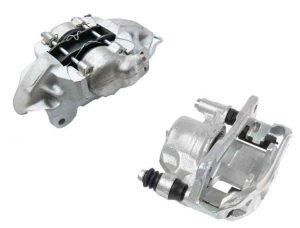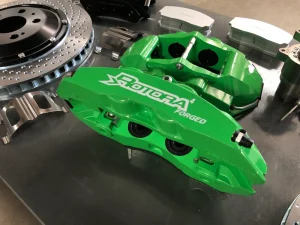When it comes to vehicle safety and performance, few components are as important as the braking system. At the heart of disc brakes lies the brake caliper, which presses the brake pads against the rotor to create the friction needed to slow or stop your car. While all calipers perform the same essential function, their design and performance vary significantly depending on whether they are floating or fixed.
Understanding the differences between floating and fixed calipers can help you choose the right option for your driving style, vehicle type, and budget.
What Are Brake Calipers?

Brake calipers house the pistons and apply clamping force on the brake pads when you press the pedal. They translate hydraulic pressure into mechanical braking force. Without calipers, disc brakes simply wouldn’t work.
There are two main types used in modern vehicles:
-
Floating (or sliding) calipers
-
Fixed calipers
Each type has advantages and disadvantages, which we’ll explore below.
Floating Brake Calipers
Floating calipers are the most common design found in everyday vehicles. They are mounted on guide pins that allow them to slide laterally. A single piston (sometimes two) pushes the inner brake pad against the rotor, and the caliper then slides to pull the outer pad into contact.
Features of Floating Calipers
-
Usually contain 1–2 pistons.
-
Lightweight and compact design.
-
Relatively inexpensive to produce and replace.
-
Found in passenger cars, small SUVs, and light trucks.
Pros and Cons of Floating Calipers
| Advantages | Disadvantages |
|---|---|
| Affordable and easy to manufacture. | Can wear unevenly due to sliding motion. |
| Lighter weight improves fuel efficiency. | Sliding pins can seize if not lubricated. |
| Simple maintenance and replacement. | Less braking power compared to fixed calipers. |
Fixed Brake Calipers
Fixed calipers are mounted rigidly to the vehicle’s suspension and do not move laterally. Instead, they use pistons on both sides of the rotor to push pads inward simultaneously. This design provides more consistent pressure distribution and better performance.
Features of Fixed Calipers
-
Typically contain 2, 4, 6, or even 8 pistons.
-
More common in performance, luxury, and heavy-duty vehicles.
-
Provide stronger and more even clamping force.
-
Offer superior heat dissipation during heavy braking.
Pros and Cons of Fixed Calipers
| Advantages | Disadvantages |
|---|---|
| Superior braking performance and responsiveness. | More expensive to produce and buy. |
| Even pad wear for longer component life. | Heavier, which may add unsprung weight. |
| Better heat management under stress. | Requires more complex maintenance. |
Floating vs. Fixed: A Side-by-Side Comparison
| Aspect | Floating Calipers | Fixed Calipers |
|---|---|---|
| Design | Slides on pins, uses 1–2 pistons. | Stationary, pistons on both sides. |
| Cost | Affordable, widely available. | More expensive, premium option. |
| Performance | Adequate for daily driving. | Superior braking force and stability. |
| Maintenance | Easier and cheaper to service. | More complex, costly repairs. |
| Pad Wear | Can be uneven. | Even distribution of pressure. |
| Applications | Passenger cars, economy vehicles. | Sports cars, luxury models, heavy-duty trucks. |
Which Brake Caliper Is Better?
The answer depends on your driving style, budget, and vehicle type:
-
Choose Floating Calipers if:
-
You mostly drive in the city or on highways.
-
You want a cost-effective solution.
-
Your vehicle is a daily commuter or light-duty car.
-
-
Choose Fixed Calipers if:
-
You drive a performance vehicle or sports car.
-
You regularly tow or carry heavy loads.
-
You value braking performance over cost.
-
In short: floating calipers are practical and affordable, while fixed calipers deliver high performance at a higher price point.
Common Issues with Both Types
No matter which type your car uses, calipers require proper care. Common problems include:
-
Sticking pistons or sliding pins → causes brake drag.
-
Brake fluid leaks → reduces hydraulic pressure.
-
Uneven pad wear → especially in floating calipers.
-
Overheating → can warp calipers and rotors.
Maintenance Tips for Brake Calipers

To extend the life of your calipers and ensure safety:
-
Inspect calipers regularly during brake service.
-
Lubricate sliding pins on floating calipers.
-
Replace damaged seals and boots promptly.
-
Flush brake fluid every 2 years to prevent corrosion.
-
Replace worn calipers if pistons seize or housings crack.
If you notice any issues or your vehicle needs replacement parts, you can buy Brake Caliper online for reliable, high-quality options that fit your car.
Conclusion
Brake calipers are truly the heart of a disc brake system, and choosing between floating vs. fixed calipers depends on what you need most: affordability and simplicity or maximum performance and durability.
-
Floating calipers are lightweight, cost-effective, and perfect for daily drivers.
-
Fixed calipers provide stronger, more consistent braking and are favored in sports, luxury, and heavy-duty vehicles.
Regardless of which type your car uses, regular inspection and maintenance are essential to ensure your braking system keeps you safe on the road. When replacement time comes, make sure to invest in quality components — buy Brake Caliper online and restore confidence in your vehicle’s stopping power.